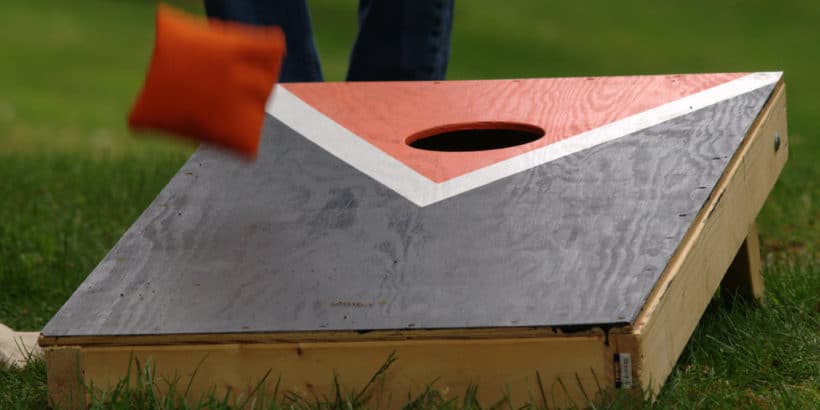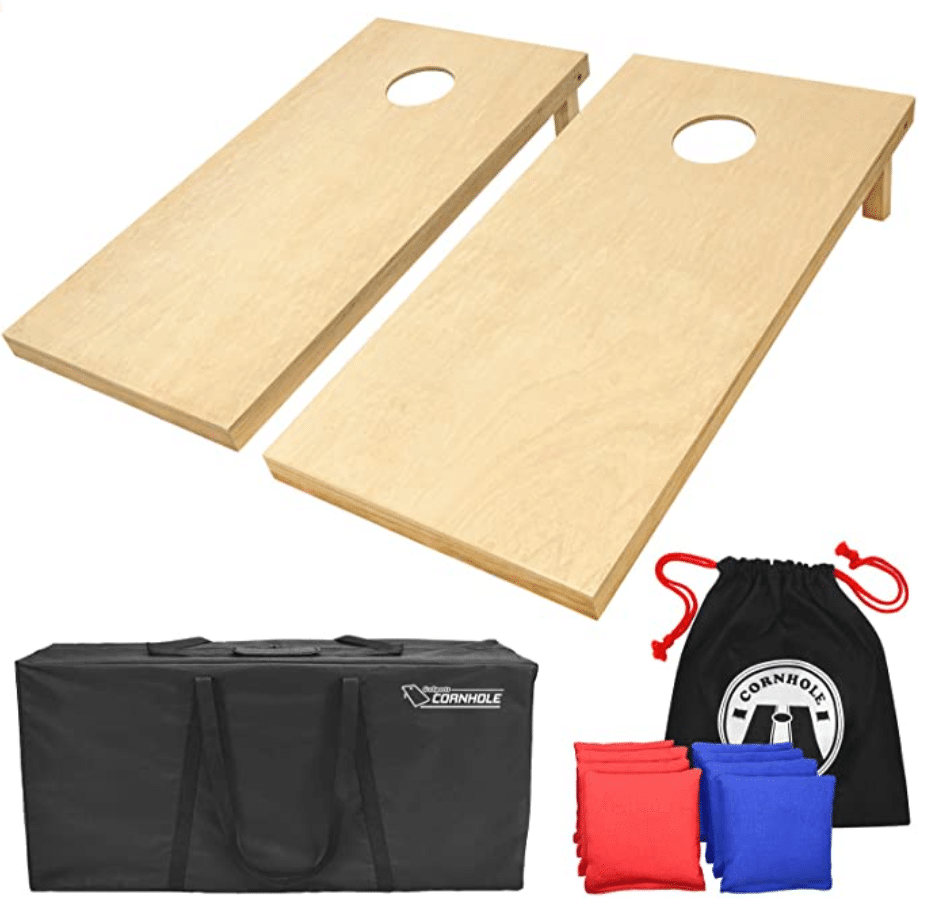Are you thinking about getting a cornhole board or trying to find our more about cornhole boards? Well, this article has got you covered.
There are a few things to consider before buying cornhole boards and this article will explain everything you need to know before deciding to go forward with a purchase so that you end up with the perfect cornhole board.
Regulation cornhole boards
The first thing you want to think about is whether or not you want a regulation-sized cornhole board.
I would recommend going with a regulation-sized cornhole board just make things easy. Personally, I use this regulation-sized cornhole board and I’ve been very pleased with it.
Here are the basic ACO cornhole board dimension standards for ACO approved boards:
- Hardwood plywood playing surface measuring 48” x 24”
- Playing surface with a minimum thickness of 1/2” with cross-section backing, or 3/4” with or without cross-section backing.
- Each hole is 6” diameter, centered 9” from the top of the board and centered from each side edge.
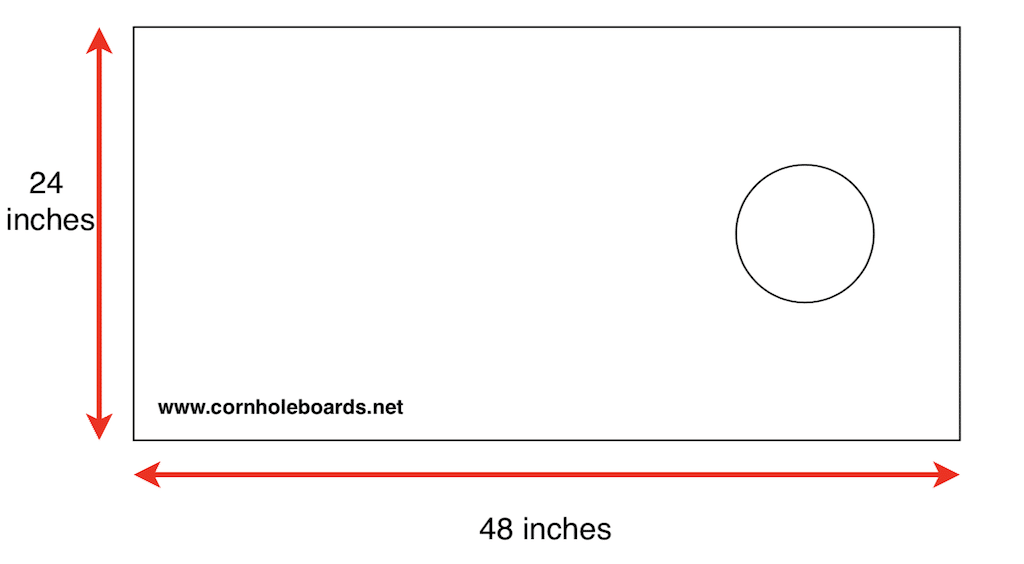 Cornhole board dimensions
Cornhole board dimensions
The biggest question you probably want to decide is if you want a cornhole board with a 3/4″ thick plywood playing surface or a 1/2″ thick plywood playing surface.
3/4″ thick plywood playing surface
A board with a 3/4″ thick plywood playing surface is going to be much more sturdy. You probably will not notice much bounce if any when using a thick board like this.
But the drawback is that the board is going to be much heavier, which can be a burden when trying to get out to parties and other special events.
Some people will add a supporting cross beam to a board with a 3/4″ thick playing surface but I personally feel like that’s overkill given how heavy the board gets. However, if you don’t plan on moving your board very much then having a bulky board isn’t a huge deal.
1/2″ thick plywood playing surface
Going with the 1/2″ playing surface is going to be much lighter and it’s what I recommend. It just makes life easier since you can move around the boards easier and carry them out to parties or events if needed.
It is a good idea to have some sort of cross support beam on a board that is only 1/2″ thick.
This helps to stabilize the board so that the bags don’t constantly bounce off the board when they are tossed. You don’t always need a cross beam to stabilize your board but I recommend it.
If you’re wanting a cornhole board that’s a decent weight that’s not too heavy, I recommend going with the cornhole board that I use right here.
Get a quality cornhole board set right now!
Check out my #1 recommendation for a quality cornhole board set that is perfect for beginners.
Tailgate-sized boards
Not everybody needs a regulation-sized cornhole board.
This is especially true if you’re not going to be playing on a regulation sized cornhole court.
A full regulation sized cornhole court is 45 feet by 8 feet and looks like the diagram below.
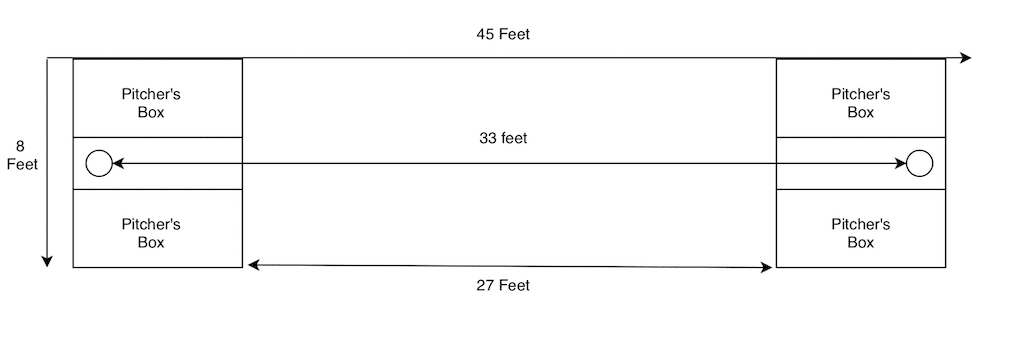
As you can see, the proper regulation distance between the two cornhole boards should be 27 feet.
But not everybody has enough room in their backyard, tailgate, etc. for that. So a lot of people will play about 24 feet apart from each other.
And if you’re a little worried about having enough room for your cornhole game, one of the best things that you can do is go with a tailgate-sized cornhole board. You can find a quality tailgate sized cornhole board here.
These boards are usually 3 feet by 2 feet instead of 4 feet by 2 feet. So they are the same width, it’s just that they are one foot shorter in length.
One foot might not sound like a whole lot of space but when you have two boards, that’s two feet of extra space which can actually make a big difference.
Even though the boards are smaller, you should be able to use the same size bean bags as you would with a normal sized board, although some people do play with small cornhole boards.
So by adjusting the distance between the boards and going with smaller boards, you can keep the game challenging since closer boards that are smaller help to equalize the competitive edge a bit.
Smaller boards
Some people like to play with even smaller boards than tailgate-sized. There are what’s called junior boards which are even smaller.
Junior-sized cornhole boards come in a few different sizes but I would probably go with a board that is at least 2 feet by 1 foot. These are different from the mini-cornhole boards.
Personally, I’d just allow juniors to play 21 feet from the cornhole boards to level the playing field.
That’s how the ACO handles junior play. But some people still like to get the smaller boards. Those smaller boards can also be useful when trying to play cornhole indoors so it’s not a bad idea to have them on stand-by.
PVC cornhole boards
If you don’t want a wooden cornhole board they make very portable tailgate-sized cornhole boards with PVC frames which could be a lightweight alternative.
These lightweight cornhole set-ups will obviously giver you a much different type of game experience since they are not nearly as sturdy as wooden boards.
However, if you’re primarily concerned with portability then these boards are not bad alternatives to consider.
Decals and skins
When purchasing or ordering a cornhole board you want to think about whether or not you want to put decals or skins on the board.
Cornhole decals
Decals can be a great way to personalize your board and they aren’t too difficult to put on if you know what you’re doing.
There are different methods for applying decals (dry method versus wet method) and many people like to apply a clear coat over the decals as well. so there are quite a few factors you want to think about before applying your decals.
You can read my guide for applying cornhole decals here.
Cornhole skins
Skins are essentially decals that cover the entire playing surface of your cornhole board. They are a little harder to put on than decals since they are so big so it’s basically the same process.
What type of wood?
If you’re ordering a custom-made cornhole board, something that you want to inquire about is the type of wood being used.
I like boards with birch plywood because it’s on the cheaper side but often still high quality. But some other boards could use maple, oak, pine, etc. Some of these woods can get pretty expensive depending on the type used, so always make sure that you inquire about your different options for choosing your wood.
- Read more about the different types of wood you can use for these boards here.
Smooth surface
Regardless of the type of wood for the cornhole board that you use, you want to make sure that your cornhole board has a nice slick surface so that the bags will slide on the board.
To accomplish this, it’s a good idea to have your wooden board sanded smoothly. Many also like to apply a clear coat (poly coat) to make sure that their boards remain nice and slick.
But you need to be careful because it’s possible that your board can become too slick and the bags will slide right off making game play way too difficult.
Cornhole bags
You always want to consider the bags, too.
Many times you can purchase a cornhole set that comes with both the cornhole boards and cornhole bags. For example, the set I got from Amazon comes with everything that you need (including a sack to store your bags in).
ACO bags
According to the ACO, cornhole bags should abide by the following standard:
- Each bag is made from two fabric squares with double-stitched seaming.
- The bags should be made from a durable fabric like canvas, twill, or synthetic suede.
- Each bag measures roughly 6” by 6” and weighs 15 to 16 ounces
The big question that you need to consider here is whether you want to use corn-filled bags or plastic resin filled bags. There are other options out there like beans, aquarium rocks, etc., but generally corn-filled and plastic resin are the two most popular options.
Corn-filled bags
Corn-filled bags are great because they are the traditional way to play cornhole (hence the name of the sport). But they also produce a fine dust when you play that can help your bags slide up the board (and hopefully into the hole).
The down side to corn-filled bags is that they can invite critters inside along with mold and or mildew. So corn-filled bags require you to keep up with them on a regular basis and not allow them to get exposed to the elements.
Another downside is that the corn will break down over time. Eventually, after a lot of heavy use, your bags will be broken down so much that they won’t be easy to throw anymore.
Plastic resin filled bags
Plastic-resin filled bags are great because they are usually weatherproof so they can take more abuse. You don’t have to worry about little critters or even animals being attracted to your bags and they last much longer.
And while they don’t produce as much dust as corn-filled bags, it’s possible to get a little bit of that dust when playing outdoors enough.
- To learn more about the corn-filled versus plastic-resin debate, click here.
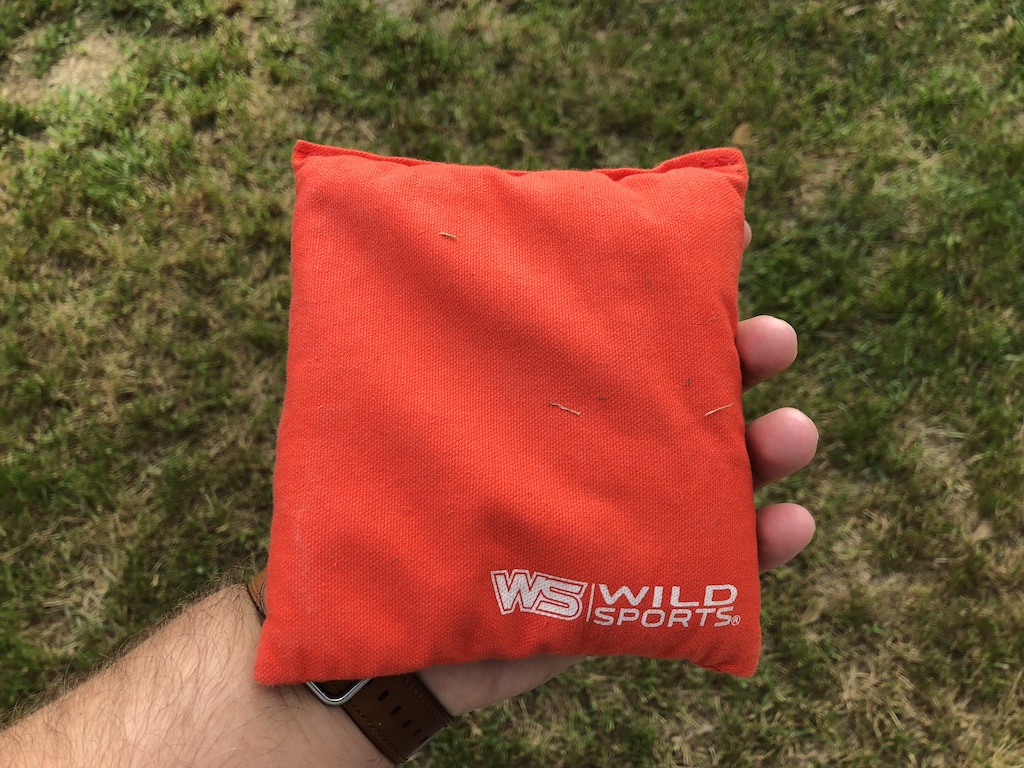
Cornhole accessories
There are a few cornhole accessories that I think that are good ideas to get.
The most useful cornhole accessories are scoreboards. Scoreboards come in many different forms. Some are stands (that also come with drink holders) and others are magnetic strip score keepers that go on the back of your cornhole board.
Getting a scoreboard is a good way to keep your game running smoothly.
A cornhole board carrying case might just be the perfect cornhole accessory for you if you plan on taking your boards out to events since those boards can get quite heavy.
Get a quality cornhole board set right now!
Check out my #1 recommendation for a quality cornhole board set that is perfect for beginners.
Cornhole tournaments
If you’re interested in playing in cornhole tournaments (or you just want to read more about these tourneys) then you should check out my article on them here.
They are held all over the country and you can work your way up and end up playing in some tournaments that are even televised on ESPN if you make it far enough.
If you just want to set up your own cornhole tournament then you can click here for custom brackets.
How does cornhole scoring work?
There are three different types of outcomes you can have when throwing your bags: cornholes, woodies, and fouls.
- Cornholes are worth 3 points and you score a cornhole whenever your bean bag makes it through the hole in the cornhole board.
- Woodies are worth 1 point and are those bags that remain set on the cornhole board (also called playing surface).
- Foul bags are worth zero points and are those bags that aren’t cornholes and aren’t woodies.
There are some other things you should know about such as how to determine fouls and you can read more about cornhole scoring here.
Cornhole rules
Now that you know what type of cornhole board that you want to get, you should read up on the cornhole rules to make sure that you know how to play.
Final word
Cornhole boards some in all different shapes and sizes and depending on your specific needs, you may want to go with a regulation-sized cornhole board or a tailgate-sized cornhole board.

